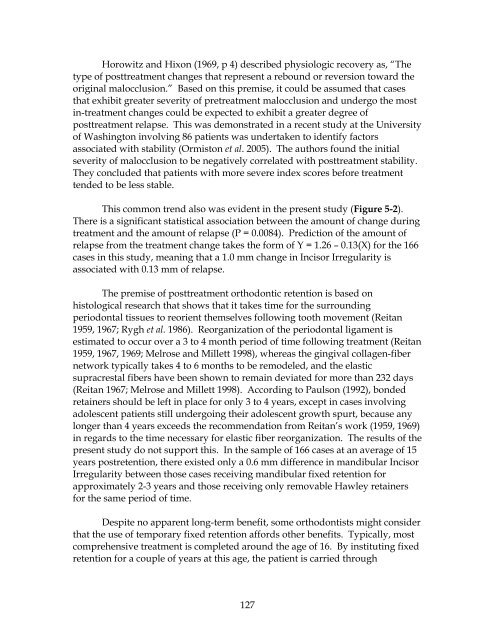EFFICACY OF TEMPORARY FIXED RETENTION FOLLOWING ...
EFFICACY OF TEMPORARY FIXED RETENTION FOLLOWING ...
EFFICACY OF TEMPORARY FIXED RETENTION FOLLOWING ...
Create successful ePaper yourself
Turn your PDF publications into a flip-book with our unique Google optimized e-Paper software.
Horowitz and Hixon (1969, p 4) described physiologic recovery as, “The<br />
type of posttreatment changes that represent a rebound or reversion toward the<br />
original malocclusion.” Based on this premise, it could be assumed that cases<br />
that exhibit greater severity of pretreatment malocclusion and undergo the most<br />
in-treatment changes could be expected to exhibit a greater degree of<br />
posttreatment relapse. This was demonstrated in a recent study at the University<br />
of Washington involving 86 patients was undertaken to identify factors<br />
associated with stability (Ormiston et al. 2005). The authors found the initial<br />
severity of malocclusion to be negatively correlated with posttreatment stability.<br />
They concluded that patients with more severe index scores before treatment<br />
tended to be less stable.<br />
This common trend also was evident in the present study (Figure 5-2).<br />
There is a significant statistical association between the amount of change during<br />
treatment and the amount of relapse (P = 0.0084). Prediction of the amount of<br />
relapse from the treatment change takes the form of Y = 1.26 – 0.13(X) for the 166<br />
cases in this study, meaning that a 1.0 mm change in Incisor Irregularity is<br />
associated with 0.13 mm of relapse.<br />
The premise of posttreatment orthodontic retention is based on<br />
histological research that shows that it takes time for the surrounding<br />
periodontal tissues to reorient themselves following tooth movement (Reitan<br />
1959, 1967; Rygh et al. 1986). Reorganization of the periodontal ligament is<br />
estimated to occur over a 3 to 4 month period of time following treatment (Reitan<br />
1959, 1967, 1969; Melrose and Millett 1998), whereas the gingival collagen-fiber<br />
network typically takes 4 to 6 months to be remodeled, and the elastic<br />
supracrestal fibers have been shown to remain deviated for more than 232 days<br />
(Reitan 1967; Melrose and Millett 1998). According to Paulson (1992), bonded<br />
retainers should be left in place for only 3 to 4 years, except in cases involving<br />
adolescent patients still undergoing their adolescent growth spurt, because any<br />
longer than 4 years exceeds the recommendation from Reitan’s work (1959, 1969)<br />
in regards to the time necessary for elastic fiber reorganization. The results of the<br />
present study do not support this. In the sample of 166 cases at an average of 15<br />
years postretention, there existed only a 0.6 mm difference in mandibular Incisor<br />
Irregularity between those cases receiving mandibular fixed retention for<br />
approximately 2-3 years and those receiving only removable Hawley retainers<br />
for the same period of time.<br />
Despite no apparent long-term benefit, some orthodontists might consider<br />
that the use of temporary fixed retention affords other benefits. Typically, most<br />
comprehensive treatment is completed around the age of 16. By instituting fixed<br />
retention for a couple of years at this age, the patient is carried through<br />
127
















